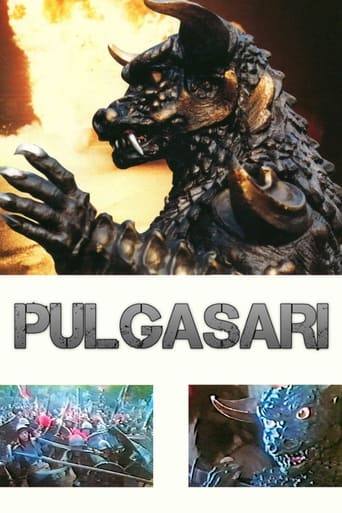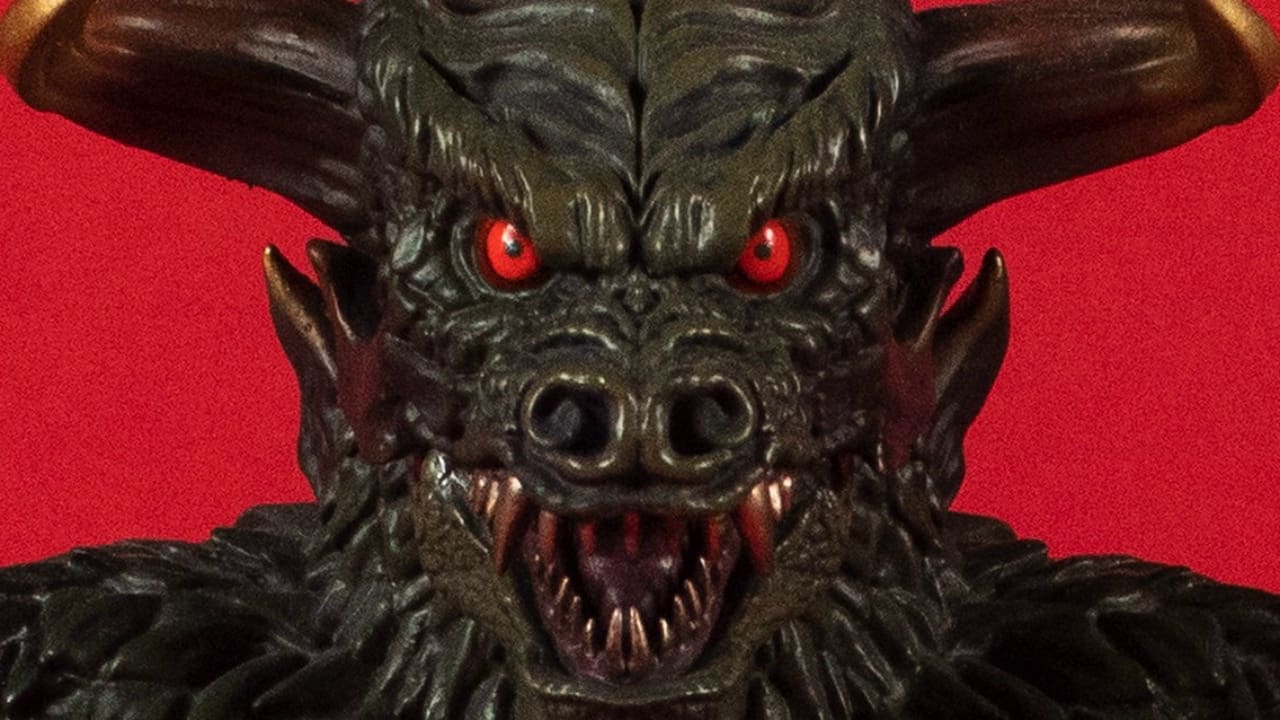Eric Stevenson
A lot of people here might not be familiar with one of my favorite pages on the entire Internet, Wikipedia's list of unusual articles. It's just a collection of weird stuff that this very movie happened to be featured on. I actually first heard about this film when watching a segment with Lewis Black on "The Daily Show". It's very hard to talk about this film at all without explaining its backstory. It was actually made when Kim Jong-Il kidnapped a movie director. Yep, this guy was actually a fan of movies and probably would have himself made a good Bond villain in real life. For a propaganda film, this didn't really have that much that was offensive in it.It's still a pretty dumb movie as it features a toy monster that comes alive when blood gets on it. The monster grows when eating iron. It's very silly, but it's really no dumber than most of the films in the Gamera series. North Korea is known for knockoff products, but this really wasn't one. It seems like every country has done a kaiju movie. Pulgasari is actually a mythical figure so it's no Godzilla ripoff. The colors in this film are just plain gaudy. Some of the action scenes really aren't that bad. It is very hard to enjoy something that was forced. Imagine if people could kidnap those who worked on their favorite franchises like "Pokémon" or "Doctor Who". George Lucas would be cliché. It's still a shame the Kim family has yet to be put to justice. Oh, and this is all the fault of religion, according to Richard Dawkins and Bill Maher. Yeah, it's hard not to get political when talking about this. **
markrschulz
Seldom have I watched a movie that fails so completely in all that it attempts to do. There could be a good reason for this, however; the director and two leads were abducted from South Korea by Kim and then forced to partake in this schlock whilst the Dear Executive Producer Kim Jong Il ran the show. This was ten years before he became the ruler of North Korea. I guess he runs his country on the same principles as he ran the production of this movie. (Un)fortunately the kidnapping victims escaped before the movie could be completed, which could explain much of the disjointed nature in the latter part of the film. Quite bizarrely, the director's 'punishment' was to have his name removed from the credits, until he SUED the film company to have it re-instated, although heaven only knows why.The movie opens in a nameless village somewhere in Chosun Dynasty era Korea. A peasant girl is fetching water from a well. She is a kind and selfless young woman, as indicated by her desire to see the old people fed first at dinner time. Her father is the town blacksmith and makes many tools for the farmers. All is not well in the idyllic village, however. An evil king sits on the throne and a great rebellion/war is brewing. He has his army appropriate all the metal in the kingdom in order to forge weapons. It emerges that the leader of the bandits/rebels lives in this particular village and has hidden a weapons cache near the blacksmith's forge. The first of many 'epic' battle scenes unfurls as Korean People's Army soldiers forced to act as extras fight it out dressed as wicked royal guards slavishly obeying the king and virtuous peasants defending their right to bear pots and pans. Yawn.The rebels are routed and arrested, and the blacksmith is then drafted to make weapons out of the confiscated metal, but allows the village people to take back their items when the army leaves. The army comes back and discovers the iron gone and this leads to his imprisonment and torture. As a form of protest, he decides not to eat and begins to starve. His daughter, Ami, tries to get him to eat rice balls by throwing them to him through the bars of the jail. He is a man of principle, however, and refuses to eat even this food prepared by his loving daughter. Instead, he makes a little figurine of the rice balls and clay and makes a dying wish to some unseen force to give it life and help the peasants. He then dies and the obligatory wailing so prolific in North Korean films starts. Once Ami, her brother, her mother, the village, the bandits, and their dogs have recovered from the loss, wiped their tears away and shouted 'aigoo' for the last time, the little sculpture finds its way to Ami. She pricks herself whilst sewing and some blood splashes onto it, bringing it to life. Pulgasari is born, and from this point on the movie never lets you forget that his name is PULGASARI! Every time PULGASARI gets screen time there is an annoying peasant/bandit/king/vizier/random extra shouting 'It's PULGASARI!', 'Hey, PULGASARI!', 'LOOK OUT IT'S
' or 'HERE COMES
' Only the heinous abomination that is 'The Outlaw of Gor' can rival the number of times the lead character's name is repeated as part of the movie dialog.So moving on, Pulgasari starts out small, he eats the needle Ami was using, then he eats the door hinges, then he eats the scrap metal in the forge. He grows bigger and bigger under Ami's control, since it's her blood that infused him with life. I immediately saw a problem with this monster; the peasants' woe is due mainly to the fact that the king wants all their metal for weapons, but their newfound hero eats the same metal. The rest of the film uses made for TV effects reminiscent of 'Mighty Morphin' Power Rangers' as Pulgasari stomps his way through Feudal Korea MiniTown, killing the king and liberating the peasants. Stuff happens along the way but the rubber suit is more convincing than the plot and character development. Predictably, the monster continues to eat metal, and becomes a burden to the peasants. Ami sacrifices herself by hiding in the village's bell before Pulgasari eats it. Pulgasari and Ami die. Roll credits on the ninety minutes of my life that cannot be taken back; a horrid mess of a movie that cannot be unseen.Reflecting on the didactic nature of the several North Korean films I have watched IE: Peasants Good/Powers that be Bad, I'd have to say that there you could interpret this as a young Kim Jong Il giving the middle finger to an establishment that had molded him from a young age to take over from his father, despite his wishes of film making glory. In 'The Flower Girl' we see how the peasants are oppressed and need the Korean Liberation Army to free them, it takes food, lives and money (metal) to support in order to drive out the Japanese Imperialists (the evil king taking the peasant's resources) but once in power, the KLA and the Communist Party continue to take all of these things from the peasants, eventually requiring the peasants to die in order to rid themselves of the scourge that they themselves have helped feed. The irony would be delicious, but I think that it's actually just a ham fisted attempt to knock capitalism; yet another aspect of this movie that fails with unintentional, yet hilarious results.
soniaandree
Straight away, I saw the movie being similar in the way the set and the actors were playing. The officials' clothes look the same, and the way of acting is also the same. The monster is created from rice and then is set upon eating the iron of the whole province, whilst destroying the government. Not so bad, there's even a moral to the story, which is that the iron-eating monster, whilst helping the villagers being free, cannot (in the end) be controlled either but this is not a reason to censor the movie. Not worth buying the DVD, but good enough to watch, this makes a light evening screening, and it is better to watch with friends.
giammarcoken
Since I began living in South Korea several years ago, I have always been curious about what life and art would be like in the isolated North. The educational channel in South Korea (EBS) has a weekly show that gives us clips of North Korean newscasts, movies, music, dramas and animation.When South Korean president, Kim Dae-jung visited North Korea last year in the first step toward normalizing relations and possible (albeit future) unification, we learned that the North Korean supreme leader is something of a movie fanatic. He has been secretly receiving western movies and monitoring South Korean tv dramas. It is not surprising to learn that he apparently ordered Pulgasari be made. Like every other artform from the North it can only be broadcast or shown if it matches the philosophy of the state. Pulgasari is a metaphor. The evil king represents the feudal government of the Chosun Dynasty which ended at the beginning of the 1900's. The monster, Pulgasari represents capitalism. It arrives apparently to help the people, but soon grows out of control. The heroes in the movie are the peasantry, the common people who must fix everything that people with power have wrought.Nobody can claim that Pulgasari is state-of-the-art. Even by rubber monster standards, this movies special effects are poor. It does help to consider that the budget for this movie was probably around what we spend on lunch in a year. But for me, the true fascination of a movie like this is the chance to see how another culture, living under a completely different philosophy, sees the world.


 AD
AD

